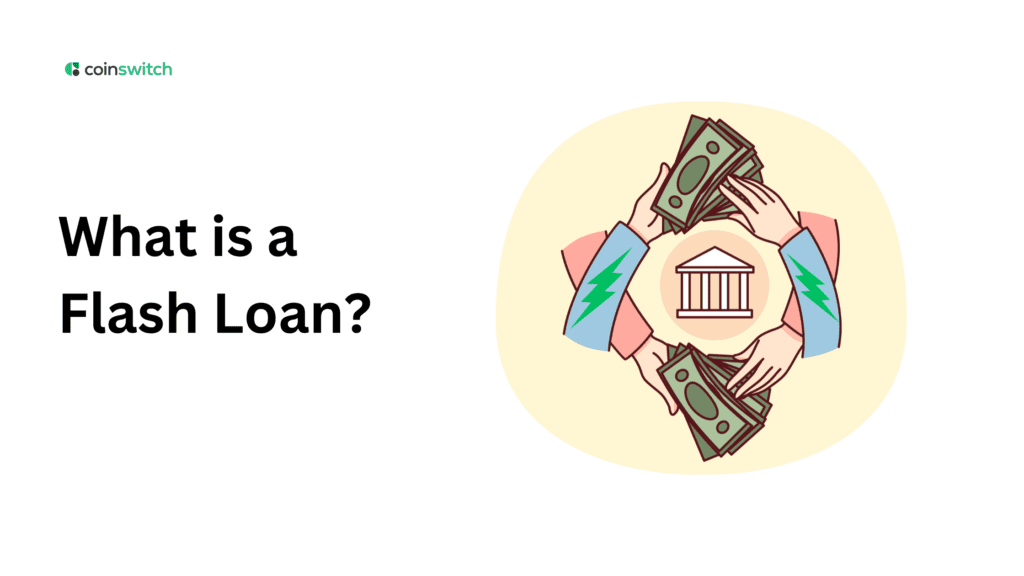Understanding Flash Loans
You might hear the phrase “borrow millions without collateral in seconds” and think it sounds like magic. In the crypto world, that magic is called a flash loan, an on-chain, uncollateralized loan that must be borrowed, used, and fully repaid in a single blockchain transaction. No collateral, no waiting days or months, just instant execution. If you fail to repay, everything reverts, as if nothing had happened.
Flash loans are a financial primitive unique to decentralised finance (DeFi). As smart contracts enforce atomicity (all steps succeed or all steps rollback), flash loans are safe from default in the traditional sense; the protocol never loses the funds if you can’t repay.
They unlock a temporary superpower: massive capital for one transaction. That capital can power arbitrage, liquidity shifts, collateral swaps, whatever your smart contract can orchestrate, as long as you can repay it within the same transaction.
How Do Flash Loans Work?
Let’s break down the steps, simple in concept, delicate in execution.
- You call a flash loan function in a lending protocol that supports flash loans. For example, Aave has flashLoan or flashLoanSimple functions.
- The protocol transfers the borrowed assets to your contract (or wallet). At this moment, you have temporary capital.
- Your smart contract executes actions (arbitrage, swaps, liquidations, rebalancing, etc.) using those borrowed funds. All steps must be inside that same transaction.
- At the end, you must repay the borrowed amount + fee to the protocol. If that fails, the protocol reverts the entire transaction (so it’s like it never happened).
- If the repayment (plus fee) happens, you keep whatever profit remains after that.
Here’s a simplified example:
- You borrow 1,000 USDC via flash loan
- You swap USDC → Token A on DEX1, then Token A → USDC on DEX2 (taking advantage of a price difference)
- You now have slightly more USDC than you started
- You repay the 1,000 USDC plus a small fee
- The leftover net is your profit
Because the blockchain enforces atomicity, there’s no risk to the lender or pool, either your path executes fully (you paid back) or it reverts.
In reality, flash loans often chain through multiple protocols, routes, and liquidity pools in one complex transaction. The logic lives in your smart contract, which must orchestrate every step.
Protocols like Aave allow borrowing from multiple reserves in one flashLoan call. Others support simpler single-asset flash loans.
What Are Flash Loans Used For?
Flash loans are powerful tools. Here are some common use cases:
1. Arbitrage
Probably the most common. Suppose Token X trades at $100 on DEX A and $101 on DEX B. You flash borrow, buy on A, sell on B, repay, and pocket the spread, all in one transaction.
2. Liquidation opportunities
If someone’s collateralized loan is undercollateralized, you can use flash loans to borrow funds, repay part of their debt to trigger liquidation, claim collateral, convert collateral back, repay your flash loan, and keep the excess.
3. Collateral swapping/refinancing
You may want to change collateral types in a lending protocol (e.g. change from ETH-collateral to stablecoin collateral). Flash loans let you pay off your loan, swap collateral, and re-borrow, all in one shot.
4. Market manipulation/exploits (often malicious)
Flash loans can be used to temporarily inflate or deflate prices, manipulate oracles, or exploit protocol vulnerabilities. Attackers use them to manipulate a protocol’s internal state temporarily, then revert.
5. Capital efficiency
Flash loans let you access large liquidity without tying up your own capital. For use cases where you need bulk funds just for a moment, it’s extremely efficient.
In short: arbitrage, liquidation, swapping, exploits, and capital leverage.
Read More: What is a DEX: An Explainer
Flash Loans and Price Oracle Attacks
This is where the darker side of flash loans comes out. Many DeFi protocols rely on price oracles, sources of off-chain or external price data, to decide collateral value, liquidation triggers, or swapping ratios. If an attacker can manipulate that oracle temporarily, they can trick a protocol into mispricing assets, then take advantage of that mispricing using flash loans.
For example:
- You flash-borrow a large amount of Token A
- You push it into a DEX to inflate its price temporarily
- You feed that manipulated price into the protocol’s oracle
- The protocol thinks Token A is worth more, allowing you to borrow more against it
- You cash out, repay your flash loan, manipulate state back, or revert parts
These oracle manipulation attacks have caused hundreds of millions in losses.
Protocols guard against this via time-weighted average price (TWAP) oracles, multi-source oracles, delayed pricing, or oracle smoothing. But flash loans remain a top exploit vector.
Security research also shows that static and dynamic analysis tools are needed to find flash loan vulnerabilities across interconnected contracts and oracles.
Because flash loans allow extreme capital in one transaction, they break assumptions of many protocols. A single misstep in Oracle design or contract logic is enough to let an attacker run away with funds.
Read More: All about DeFi loans: How does DeFi lending work?
Flash Loans vs. Traditional Loans
Flash loans defy many rules of conventional lending. Here’s how they differ:
| Feature | Traditional Loan | Flash Loan |
|---|---|---|
| Collateral | Required (e.g. property, like a house) | None (must repay within the same transaction) |
| Duration | Days, months, years | Single blockchain transaction (atomic) |
| Risk of default | Lender bears risk, uses collateral | Impossible to default, transaction reverts |
| Eligibility | Credit checks, KYC, contract terms | Anyone who can write or use the smart contract path |
| Use flexibility | Borrow, repay later, interest accrues | Must repay immediately, limited to instant use |
| Examples | Bank loan, mortgage, crypto collateral loans | Arbitrage, liquidation, collateral swap, exploits |
Because of these differences, flash loans are not suited for long-term borrowing. They’re built for ultra-short, atomic use cases where the logic must resolve immediately.
In traditional loans, your collateral secures the risk. In flash loans, the atomic execution and revert mechanism secures the risk.
Conclusion
A flash loan is one of DeFi’s wildest innovations: borrow vast sums without collateral, use them in complex financial plays, then repay, all in the blink of a blockchain transaction. It’s a tool made possible by smart contracts and atomic execution.
When used ethically, flash loans enable efficient arbitrage, collateral swaps, and capital-efficient strategies. When abused, they fuel price oracle attacks and exploit weak protocols.
As DeFi matures, the balance lies in protocol design: building systems that allow flash loans’ creativity but resist vulnerability.
FAQs
1. What does “flash” mean in crypto?
“Flash” signals instant and atomic; in the case of flash loans, you borrow and repay within the same transaction. No delay. No hanging debt.
2. How to get a crypto flash loan?
You use a protocol that supports flash loans (e.g., Aave). You build or use a smart contract path that executes borrow → your actions → repay, all in one transaction. If any step fails, the transaction reverts, preventing default.
3. Are flash loans safe to use?
They can be safe, for the lender side, they’re safe because they revert if not repaid. For the user, risk lies in your smart contract logic, gas costs, complex interactions, and miscalculations. Many exploits came from flash loans misused as attack vectors.
4. What is the difference between a flash loan and a traditional loan?
Traditional loans require collateral, can run from days to years, and may default. Flash loans require no collateral, must be repaid immediately (same transaction), and can’t default because if repayment fails, the transaction doesn’t go through.








